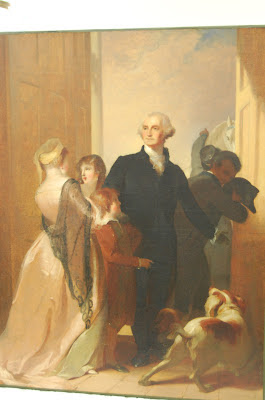My name's
Hunter Stires. I'm a 15 year old rising
high school sophomore with a keen interest in American History. I'm honored to have been invited to blog for
the Lloyd W. Smith Archives.
This month's featured manuscript is a 1917
postcard written from the Western Front to Albany, NY during the First World
War. It's amazing what can be discovered
from such an innocuous piece of paper.
Initially, the identity of the
postcard's sender was difficult to ascertain.
While his message was fairly simple to read, both signatures were
written in somewhat flamboyant calligraphy.
Here's a transcript of his note back home:
My Dear Friends: _
On
the Battlefield of the Marne,
in a corner of a French artillery
camp,
tucked away in a small room I
am writing these few lines by the
dim and flaring light of a candle
just to let you know that I am
well and thinking of my friends
back in
LWS 677
Albany whom I feel
it an honor to represent
at the Front.
Time
and the censor
forbid my writing more
Bonne
nuit!
Faithfully
yours
[Flamboyant
signature here]
After some scrutiny, his last name
appeared to be “Cochrane.” While this
was a crucial piece of evidence, more information would be required to find out
who he was. His first two initials
appeared to be “W.D.” and his signature was followed by “M.R.C.” (I'll spare
you the details of the time and effort chasing down the red herring that was
“W.D.”. It turned out to be
“H.D.”). In addition, several previously
unrecognizable scribbles in the “Reply to” section soon revealed themselves to
be an abbreviation of “Major” as well as the line, “7th Regt.
C.A.” Let the sleuthing begin.
Harold Duncan Cochrane was a
doctor from Albany, NY who, according to an article he wrote in the Journal of
the American Institute of Homeopathy in 1919, served in the railway artillery
as a regimental surgeon and then the surgeon for the entire division. Officially, he was a Major in the Medical
Reserve Corps (M.R.C.), an organization of medical doctors who would be called
up to serve with the Army in the event of war.
Major Cochrane wrote his postcard on September 20, 1917 from a French
artillery camp. Since American combat troops
didn't arrive at the Western Front until October of that year, Cochrane appears
to have been among the first American servicemen to reach the front lines.
Major Cochrane served with the
Railway Artillery, a military innovation that was fairly unique to World War
I. Large caliber guns were taken from
battleships and coastal defense installations (“C.A.” stands for “Coast
Artillery”) and mounted on railroad cars.
These weapons were far more mobile than older, fixed heavy
artillery. Since artillery was a very
valuable asset for obliterating trenches and other fortifications, commanders
would have to move their guns quickly and often to keep the enemy from finding
and destroying them. With railroad
artillery, generals had at their disposal the power of a battleship almost
anywhere along the front lines.
Cochrane's article in the Journal of
the American Institute of Homeopathy dealt with the logistical issues of
getting the wounded back to evacuation hospitals, and he wrote extensively
about his experiences with the railroad artillery in other publications as
well.
Cochrane also mentions his location
as being on the “battlefield of the Marne.”
While this phrase makes it seem like he's in combat, history tells us
that the two large-scale offensives that took place there were in 1914 and
1918, respectively. Since the First
Battle of the Marne stopped the German advance towards Paris and marked the
beginning of the infamous stalemate and trench warfare that defined the
conflict, Cochrane was giving his reader a reference point that was probably
well-known at the time.
Cochrane used YMCA stationary to
write his September 20 postcard. When
the United States declared war on Germany on April 6, 1917, the YMCA
volunteered to run the post exchange for the American Expeditionary Force (the
U.S. troops fighting in France). Among
the responsibilities involved with this critical
role was selling or making available to the troops candy, cigarettes and other
personal items, including postcards.
Cochrane's card is housed in the
Lloyd W. Smith Archives Collection at Morristown National Historical Park.
This post was written by guest blogger, Hunter Stires.

























